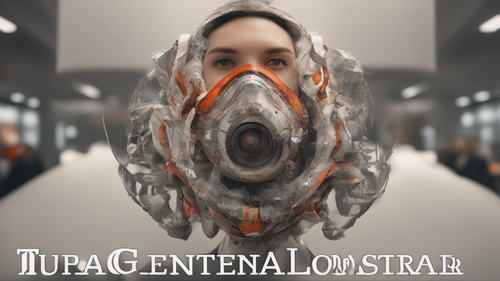
Introduction
In the realm of artificial intelligence, a groundbreaking technology has emerged that pushes the boundaries of creativity and artistic expression – the AI art generator from text. This revolutionary concept harnesses the power of machine learning and natural language processing to create stunning visual artworks based on simple textual input. The results are nothing short of extraordinary, as AI algorithms turn words into breathtaking masterpieces. This article delves deep into the fascinating world of AI art generation, exploring its capabilities, applications, and impact on the art community and beyond.
Understanding AI Art Generator from Text
The concept of AI art generation from text revolves around training advanced neural networks to understand the context and essence of written language. These neural networks, often based on GPT-3.5 architecture, can interpret text, identify themes, and generate images that reflect the underlying concepts. This technology not only sparks the imagination of artists but also finds applications in various industries, including advertising, design, and storytelling.
How AI Art Generator Works its Magic
Natural Language Processing (NLP) at Its Finest
The AI art generator's magic begins with sophisticated natural language processing algorithms. These algorithms dissect the input text, identifying keywords, sentiments, and contextual clues. By grasping the nuances of human language, the AI model gains a deeper understanding of the desired artistic output.
Transfer Learning: Drawing Inspiration from Vast Datasets
One of the keys to the AI art generator's success lies in transfer learning. These models are pre-trained on massive datasets containing diverse artistic styles, genres, and historical masterpieces. This wealth of information allows the AI to learn from the masters and create art that reflects the richness of human creativity.
Generative Adversarial Networks (GANs) in Action
Generative Adversarial Networks (GANs) play a pivotal role in the AI art generation process. GANs consist of two neural networks, the generator, and the discriminator, engaged in a creative battle. The generator crafts art from text, while the discriminator critiques it. This continuous feedback loop leads to the production of increasingly realistic and impressive artworks.
The Versatility of AI Art Generator from Text
Unleashing the Imagination of Artists
AI art generation is not here to replace artists; instead, it serves as an inspiring tool to amplify their creativity. With AI-generated sketches and concepts, artists can explore new ideas, experiment with various styles, and push the boundaries of their artistic vision.
Empowering Content Creators
Content creators in industries like marketing, publishing, and game development benefit from AI art generation. By simply describing scenes, characters, or settings, they can swiftly access a visual representation of their ideas, streamlining the creative process.
Revolutionizing Storytelling
The impact of AI-generated art extends beyond individual pieces; it transforms storytelling. Authors and scriptwriters can bring their narratives to life by generating stunning illustrations that captivate readers and viewers alike.
AI Art Generator from Text in the Real World
AI Art in Advertising: Captivating Audiences
In the world of advertising, creativity is a driving force. AI-generated art allows marketers to craft visually striking campaigns that resonate with audiences, leaving a lasting impression and driving brand engagement.
Design Industry: Enhancing Creativity
From graphic design to interior design, AI-generated art inspires innovation. Designers can quickly visualize concepts, experiment with layouts, and fine-tune their ideas, all with the aid of AI-generated visuals.
Personalized Art for Everyone
The accessibility of AI art generation democratizes artistic expression. Anyone can describe their vision, and within moments, witness it come to life as a personalized artwork.
Education and Museums: Bridging the Gap
AI art generation opens up new possibilities for education and museums. Historical artifacts can be reconstructed in stunning detail, enabling learners to experience history in a visually immersive manner.
The Future of AI Art Generator from Text
AI and Human Collaboration: A Harmonious Symphony
As AI art generation continues to evolve, it will integrate more seamlessly with human creativity. Artists and creators will form symbiotic partnerships with AI, unleashing unprecedented artistic possibilities.
Ethics and AI Art: Navigating New Territory
The rapid advancement of AI art raises ethical questions. How do we attribute authorship? What happens when AI-generated art mimics copyrighted works? Addressing these concerns will be critical as the technology progresses.
Beyond Visual Art: Music, Poetry, and More
While AI art generator from text is predominantly visual, the same principles can be applied to other creative domains like music and poetry, enabling AI to become a multi-faceted muse.
FAQs
Can AI art surpass human creativity? AI art is not meant to replace human creativity but rather to complement it. While AI can create impressive artworks, the essence of human imagination remains unparalleled.
How can AI-generated art be used responsibly? Responsible use of AI art entails giving proper credit to human artists who provided the input and ensuring that AI-generated content respects copyright laws.
What sets AI art generation apart from traditional art tools? AI art generation provides a novel way to ideate and visualize concepts swiftly, making it an invaluable addition to the artist's toolkit.
Can AI-generated art be considered original? AI-generated art is unique in its creation process, but the question of "originality" in the artistic sense remains open to interpretation.
What ethical challenges does AI art pose for the art community? The art community must navigate the ethical complexities surrounding authorship, intellectual property, and the preservation of human creativity.
How will AI-generated art impact the art market? The rise of AI-generated art raises questions about its valuation, commercialization, and integration into the traditional art market.
Conclusion
AI art generator from text is a transformative technology that merges human language and machine creativity in unprecedented ways. Its applications span across industries, from advertising and design to education and storytelling. The future of AI art holds infinite possibilities, where humans and AI collaborate harmoniously to unlock new realms of artistic expression. As we navigate this innovative landscape, it is essential to embrace AI-generated art responsibly and preserve the spirit of human creativity that defines us. Step into the world of AI art and let your imagination soar with boundless potential.